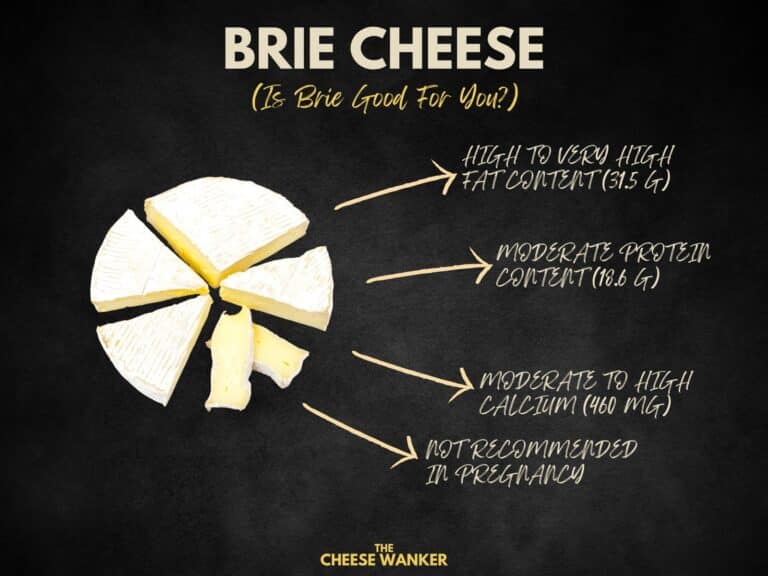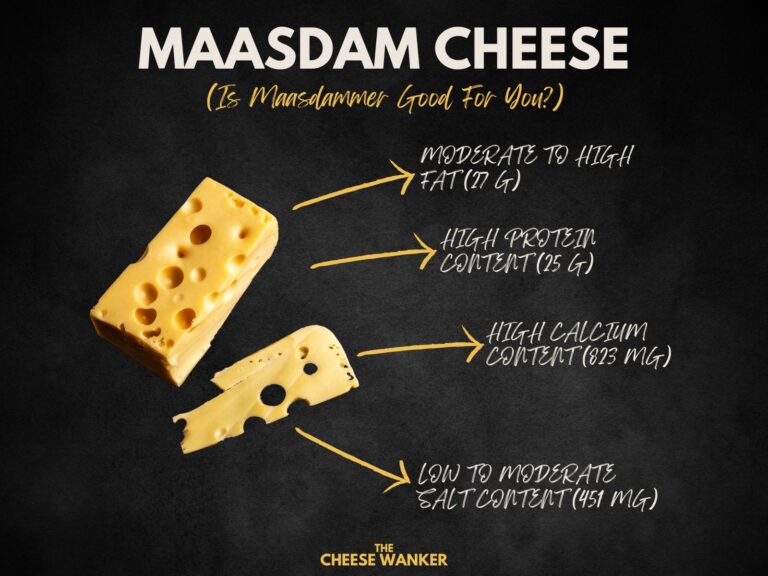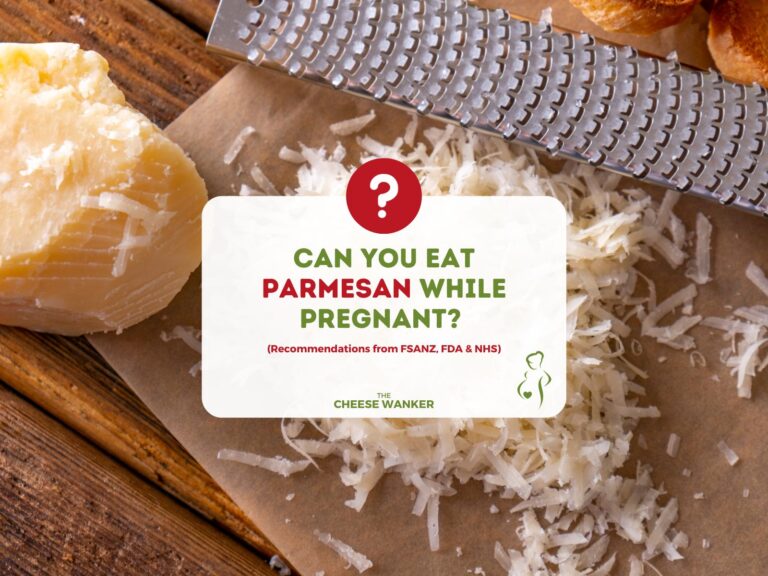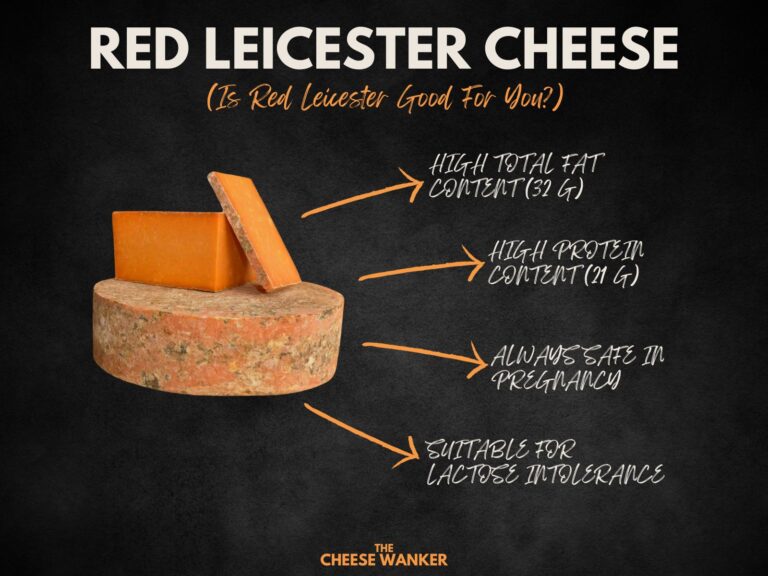Parmesan cheese, a staple in many kitchens, is renowned for its distinctive taste and aromatic profile. Its organoleptic properties, including a crumbly texture and robust flavour, make it a favourite among cheese lovers and gourmet food enthusiasts. In this blog post, we delve into the nutrition facts for Parmesan to find out whether it is a healthy choice.
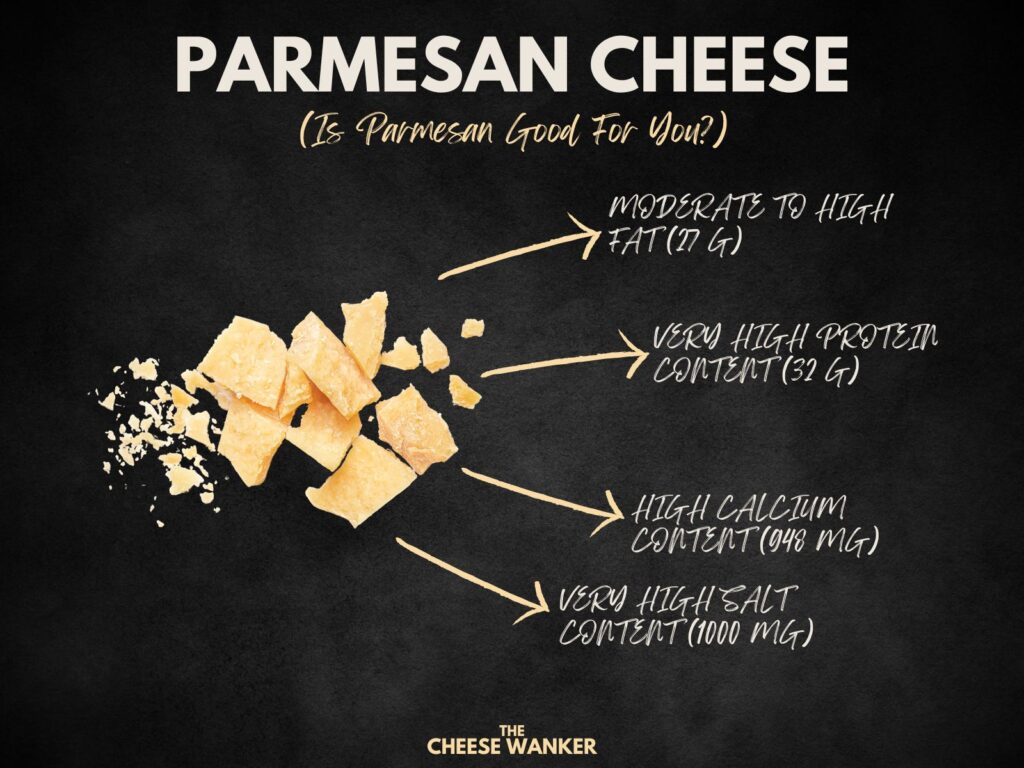
SEE ALSO: Nutrition facts for popular world cheeses in The Cheese Wanker’s index →
What is Parmesan cheese?
Parmesan, hailing from the Emilia-Romagna and Lombardy regions of Italy, undergoes a meticulous production process. Aged for at least 12 months, it acquires a unique texture and taste.
Organoleptic properties, such as the crystalline crunch and savoury notes, define Parmesan’s distinctiveness. Typically grated or shaved, it enhances various dishes, from pasta to salads.
Nutrition fact sheet
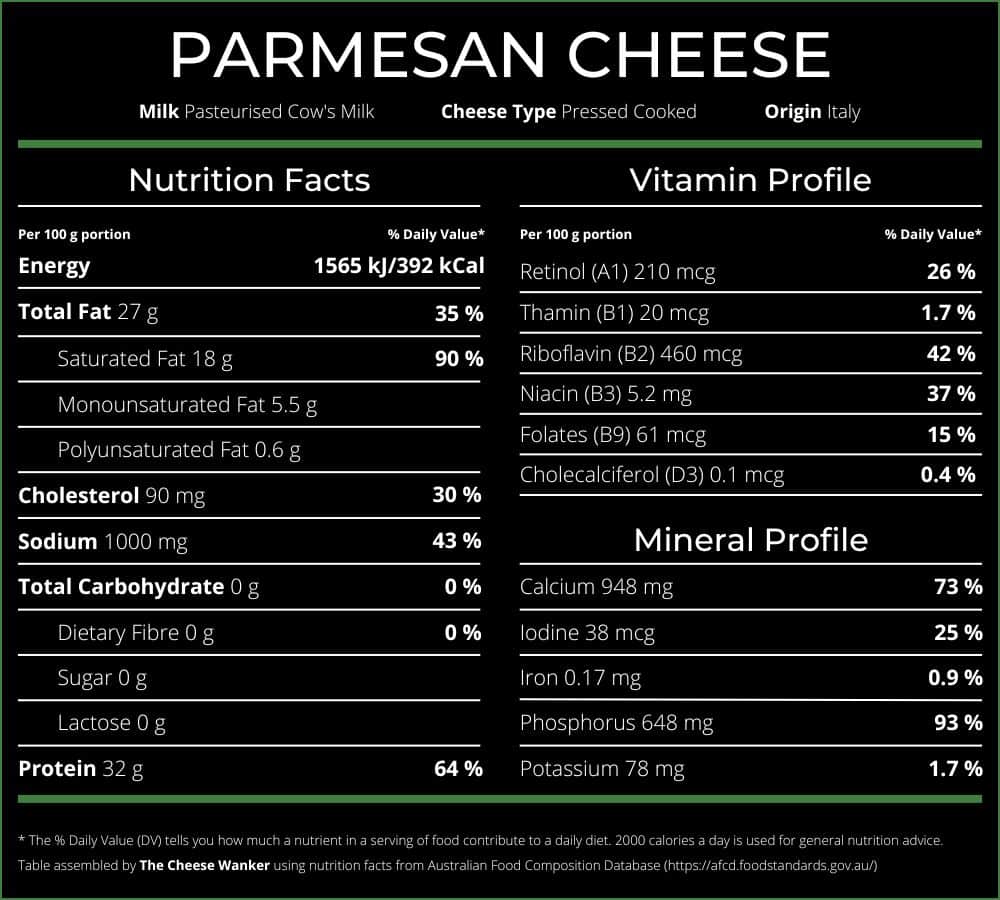
Nutritional review for Parmesan
Eating healthy plays a pivotal role in maintaining overall well-being and preventing chronic diseases. A balanced and nutritious diet provides our bodies with essential vitamins, minerals, and macronutrients, fuelling optimal physical and cognitive function.
With this in mind, let’s have a look at some of the key nutrition facts for Parmesan.
Calorie Count
Starting with the calorie count, Parmesan packs a punch at 392 calories per 100 grams. This calorie density underlines its potential for adding richness to dishes, prompting judicious use for those mindful of caloric intake.
Beyond the numerical value, Parmesan’s calorie density signifies its potential to elevate the nutrition profile of this cheese. Indeed, macronutrients like fat and proteins also contribute to the caloric count but can make a positive contribution to our diet.
Now, let’s take a closer look at fat and protein.
Fat Content
Moderately high in fat, Parmesan’s 27 grams per serving include saturated and unsaturated fats. The predominant presence of oleic acid contributes to its heart-healthy profile, making it a preferable source of fats.
You can learn more about the different types of fat in cheese and which cheeses have the lowest fat content here.
Protein Content
Furthermore, Parmesan stands out with a remarkable protein content of 32 grams. Rich in casein and whey proteins, it serves as an excellent source of amino acids, contributing to muscle development and overall body function.
Want to find out which cheeses have the highest protein content? Click here for our blog post covering cheeses with the highest protein content.
Cholesterol Content
While Parmesan contains 90 milligrams of cholesterol, scientific consensus suggests that dietary cholesterol’s impact on blood cholesterol levels is nuanced. Current research indicates that for most people, the cholesterol in food has a limited effect on cardiovascular health.
You can learn more about the impact of dietary cholesterol on blood cholesterol levels in our dedicated post here.
Salt Content
Parmesan’s saltiness, at 1000 milligrams per serving, stems from the cheesemaking process. Excessive salt intake can pose health risks, particularly for individuals with hypertension or cardiovascular issues.
You can read more about why salt is important in cheesemaking in our comprehensive post here.
Calcium Content
Delving into Parmesan’s nutritional profile, the spotlight shines on its exceptional calcium content—standing at an impressive 948 milligrams per serving, categorised as very high.
Calcium, essential for bone health, finds a formidable source in Parmesan. Recognising its very high calcium content underscores the cheese’s importance in fortifying skeletal strength.
Particularly noteworthy is its significance for individuals at risk of osteoporosis, as Parmesan’s abundance of this vital mineral becomes a valuable asset in promoting bone density and overall well-being.
You can read more about this important mineral and find out which types of cheeses have the highest calcium content in our post here.
Other Vitamins & Minerals
Parmesan cheese isn’t just a culinary delight; it’s a nutritional powerhouse, offering a spectrum of essential vitamins and minerals:
Vitamins
- Vitamin A1: Supports vision, immune function, and skin health.
- Vitamin B2 (Riboflavin): Contributes to energy production and antioxidant processes.
- Vitamin B3 (Niacin): Essential for DNA repair and skin health.
- Vitamin B9 (Folate): Crucial for cell division and DNA synthesis.
Minerals
- Iodine: Essential for thyroid function.
- Phosphorus: Vital for bone and teeth health, energy metabolism, and DNA formation.
Safety in Pregnancy
The low moisture content in Parmesan ensures safety during pregnancy. This is because the lack of water makes this cheese an inhospitable environment for pathogens like Listeria and Salmonella.
Consequently, this makes this grana-style cheese a reliable choice, providing essential nutrients without the concerns associated with high-moisture cheeses. Having said that, its salt content is very much on the high side. Hence, we recommend consumption in moderation.
Of course, if you’re unsure of what you can eat during pregnancy, you should consult your healthcare professional to get a personalised plan. You can read more about which cheeses you can eat when you’re pregnant by clicking here.
Lactose Intolerance
Parmesan’s long maturation process renders it virtually lactose-free, making it suitable for those with lactose intolerance. Variations in lactose tolerance among individuals should be considered, and consulting a healthcare professional is advised for tailored advice.
Conclusion
In conclusion, Parmesan cheese, with its rich nutritional profile, offers a balance of flavours and health benefits. As with any food, moderation is key.
Consider the versatility of Parmesan in your culinary pursuits, but always be mindful of individual dietary needs. Embrace the scientific insights into Parmesan’s nutrition and make informed choices to elevate both your dishes and your well-being.
References
Overall nutritional content
The nutritional content of cheese in our table comes from the USDA Food Data Central Repository, the Australian Food Composition Database and cheese manufacturers. We realise that there can be variations between different brands and producers. Hence, the numbers we have used are averages.
Fat content
Our fat RDI data comes from Cleveland Clinic’s Healthy Fat Intake resource.
Type of fat in cheese as per Harvard T.H. Chan’s The Nutrition Source.
Protein content
Our protein RDI data comes from Harvard Medical School’s Harvard Health Publishing.
Cholesterol content
Is There a Correlation between Dietary and Blood Cholesterol? Evidence from Epidemiological Data and Clinical Interventions? – Maria Luz Fernandez and Ana Gabriela Murillo
Saturated fat, carbohydrate, and cardiovascular disease – Patty W Siri-Tarino, Qi Sun, Frank B Hu and Ronald M Krauss
Effect of cheese consumption on blood lipids: a systematic review and meta-analysis of randomized controlled trials – Janette de Goede, Johanna M Geleijnse, Eric L Ding, Sabita S Soedamah-Muthu
Safety in pregnancy
All the advice relating to what cheeses you can eat during pregnancy in this article is based on the recommendations by health authorities in Australia, the UK and the USA. If you are unsure about what you can or cannot eat, please consult your doctor.
Australia – FSANZ, United Kingdom – NHS and United Sates of America – FDA
Lactose content
Lactose residual content in PDO cheeses
Detection of lactose in products with low lactose content
The analysis of lactose in milk and cheese products by HPLC
Food Standards ANZ Food Composition Database
Lactose & Galactose content of cheese
